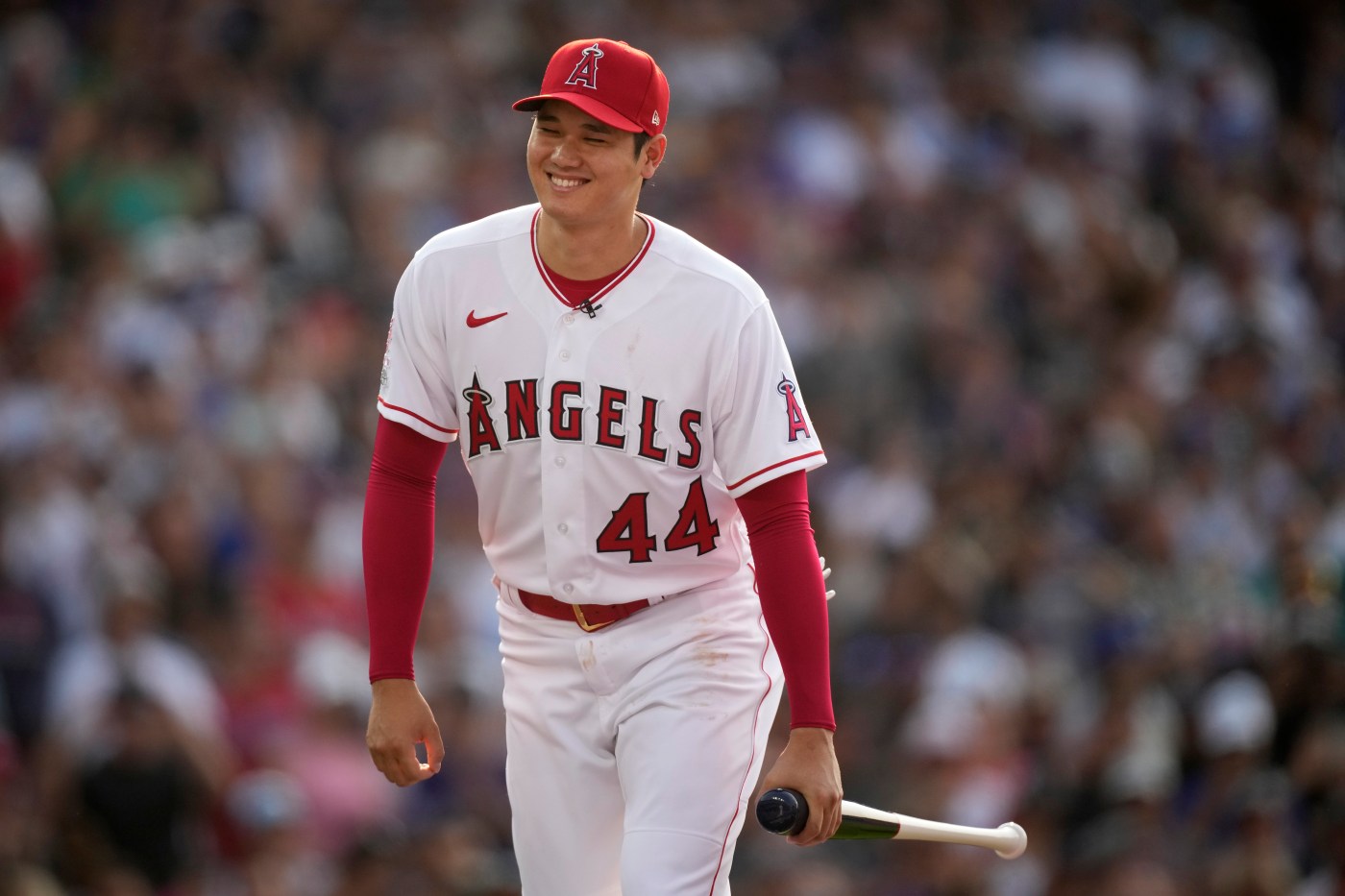
MLB Notes: What Shohei Ohtani signing with Dodgers means for the Red Sox
For a while on Friday it looked like the Red Sox were staring down a worst-case scenario.
Juan Soto had already been traded to the New York Yankees, and now speculation was ramping up that Shohei Ohtani was on the verge of joining him in the AL East. Reports broke that Ohtani was flying to Toronto on a private jet, and that a Japanese countryman had reserved an entire restaurant to celebrate his signing with the Blue Jays.
It was a done deal, or so the internet thought.
Subsequent reporting threw cold water on the Toronto narrative, and then Saturday Ohtani dropped the bombshell himself. The two-time MVP announced he will be joining the Los Angeles Dodgers, and with that Red Sox fans everywhere could take a deep breath.
Short of Ohtani signing in Boston himself, the two-way superstar staying in Los Angeles and moving to the National League is close to a best-case scenario for the Red Sox. Instead of having to deal with him up to 13 times per year with the Blue Jays, Boston will now only need to worry about him for a single three-game series at Dodger Stadium from July 19-21.
And if the Dodgers run roughshod over the league and stack well over 100 wins? Big deal. It won’t be an issue for Boston until the World Series, at which point it would become a great problem for the Red Sox to have.
The details of Ohtani’s deal are staggering, too.
According to ESPN’s Jeff Passan and others, Ohtani’s deal with the Dodgers is for 10 years, $700 million, obliterating the previous MLB record of $426.5 million set by Ohtani’s former Angels teammate Mike Trout. Passan also reported the contract has significant deferrals, which will reduce his luxury tax hit and free up more money for the Dodgers to build a contender around him.
To put that into perspective, Ohtani’s $700 million guaranteed eclipses the $530.8 million LeBron James is estimated to have earned over his entire playing career, even taking next year’s earnings into account. It also exceeds the $660 million John Henry’s ownership group originally paid for the Red Sox in 2002.
Could the Red Sox have afforded a deal like that? Probably, but it would have been an incredible risk to take. Ohtani recently had his second elbow surgery in less than five years, and for the Dodgers to get their money’s worth they’ll need him back on the mound in 2025 and beyond.
Considering that Boston needs starting pitching right now, it’s not surprising the club ultimately passed on the two-way superstar.
With Ohtani off the board the rest of the free agent market should kick into overdrive. On deck is Yoshinobu Yamamoto, the top starting pitcher available and an ideal addition for the Red Sox rotation. Jordan Montgomery, Blake Snell and other highly regarded arms won’t be far behind, so after weeks of waiting and hoping we should finally gain some clarity on what next year’s Red Sox team could look like.
Will Craig Breslow prove a more aggressive and decisive executive than Chaim Bloom? We should know by the end of the week.
Once thing is for certain, no matter what happens with the Red Sox, Los Angeles has firmly established itself as the center of the baseball world. With Mookie Betts, Freddie Freeman and now Shohei Ohtani on board, the Dodgers enter 2024 as heavy World Series favorites, giving the two-way superstar his first real opportunity to shine on the postseason stage after six years of disappointment in Anaheim.
The Dodgers have once again set the bar, now it’s on the Red Sox to see if they can match it.
O’Neill boosts Sox outfield
Days after moving Alex Verdugo, the Red Sox restocked their outfield by acquiring Tyler O’Neill from the St. Louis Cardinals. While not an impact bat like Juan Soto, O’Neill fills several needs for Boston and should be a good fit for the current roster.
A two-time Gold Glove winner, O’Neill will immediately improve Boston’s defense and can play all three outfield positions. He is also a right-handed hitter, something Boston badly needed given that Masataka Yoshida, Jarren Duran and Wilyer Abreu all bat left-handed, and has flashed significant power potential.
In 2021, O’Neill turned in by far his best season at the plate by hitting 34 home runs with 80 RBI and 15 stolen bases. He hasn’t been nearly as impactful in his other five MLB seasons, and last year he only hit nine homers with a .715 OPS in 72 games. He does have an impressive track record against left-handed pitchers, posting an .816 career OPS against southpaws.
How much O’Neill factors into the equation will probably depend on whether or not Abreu earns the starting right field job or if Ceddanne Rafaela makes the big league roster. Most likely he will see the majority of his time in left or center, especially when a lefty is on the mound, while Yoshida shifts into closer to a full-time DH role.
O’Neill also likely fits Boston’s timeline better than some of the higher profile outfielders on the free agent market.
Like Verdugo, O’Neill is in his final year of salary arbitration and is due to become a free agent next winter. He is projected to earn $5.5 million this season, about half of what Verdugo will likely make, so between that and the light haul of prospects they gave up to acquire him, the Red Sox aren’t making a huge investment bringing O’Neill in.
Considering that Boston already has Abreu and Rafaela knocking on the door, and with top outfield prospect Roman Anthony not far behind, a potential one-and-done addition like O’Neill makes more sense than giving someone like Lourdes Gurriel Jr. a three-year deal.
Is O’Neill the splashiest addition? No, but he fills a key need while leaving most of Boston’s resources freed up to address other priorities, most notably the starting rotation.
Nashville makes expansion case
Former Red Sox president of baseball operations Dave Dombrowski has lived in Nashville for a few years now. He kept his home there after joining the Phillies and has continued to spend his winters in the Music City since taking over the top job in Philadelphia.
But while right now Nashville isn’t home to an MLB franchise, Dombrowski’s hopeful that may soon change.
“I think Nashville is a tremendous city,” Dombrowski said. “There’s a lot of things about it, there’s growth all over the place, there’s something going on all the time, so to me it’s a big league city.”
Though he’s had no official involvement since joining the Phillies, Dombrowski has served as an advisor for Music City Baseball, a group dedicated to bringing an MLB expansion franchise to Nashville. The city is viewed as a top expansion candidate and this week Nashville found itself at the center of the baseball universe as host of the MLB Winter Meetings.
Nashville is already host to an NFL and NHL team, and if the city were awarded an MLB franchise, Music City Baseball says it hopes to build a $1 billion retractable-roof stadium on the banks of the Cumberland River north of downtown, near the campus of Tennessee State University. The new franchise would be called the “Nashville Stars,” honoring the city’s Negro League history as well as its current association with numerous stars in music, entertainment and sports.
Others associated with the effort include former Oakland Athletics ace Dave Stewart, Hall of Fame manager Tony La Russa and Texas Rangers manager Bruce Bochy.
“Oh, I hope it happens,” Bochy said this week. “It’s growing, it’s an exciting city. All the people I know that are here, they’re having a great time. After the meetings get out, having dinner and going to various places, listening to music, things like that. There’s a lot of action in this city so I think it’s primed and I’m certainly hoping it happens.”
Since the Oakland Athletics’ move to Las Vegas was approved by MLB’s owners and the Tampa Bay Rays announced plans for a new stadium in St. Petersburg, speculation has ramped up that expansion could be on the horizon. Commissioner Rob Manfred has repeatedly said that expansion wouldn’t happen until those clubs’ stadium situations were resolved, but now the prospect of MLB moving from 30 to 32 teams at some point by the end of the decade seems much more likely.
“I cannot speak for it, that’s for the commissioner, he’s always said they had to settle those two situations first before they talked about expansion. The reality is now those two situations look like they’re settled, so now perhaps the next step is there,” Dombrowski said. “I can’t say if it’s immediate or not, but I’d be much more optimistic now that those things are done.”
If that happens, Nashville seems to be a popular choice within the sport. Recently The Athletic polled 100 players on a variety of subjects, and when asked what city they feel would be best for a new MLB expansion franchise Nashville was the overwhelming choice. The Music City drew 69% of the vote, with Montreal finishing a distant second with 10% and Charlotte, N.C. and Austin, Texas tied for third with 5% each.
Nashville’s case isn’t unassailable. Even with the city’s recent growth it still ranks as the nation’s 26th largest television market according to Nielsen, behind other expansion candidates like Charlotte and Raleigh-Durham-Fayetteville in North Carolina and Portland, Oregon. Nashville would also rank 25th in market size among current MLB teams, but it’s also far larger than Las Vegas, where the A’s are set to move within the next few years.
The city could also draw opposition from the Atlanta Braves, who have historically dominated the southern U.S. market, and from the Cincinnati Reds, whose territory includes most of nearby Kentucky. That being said, teams from all three cities have peacefully coexisted for years in the NFL, suggesting there are enough fans to go around.
Manfred hasn’t commented publicly on Nashville or any other club being a target of expansion since the Oakland Athletics move became official, so for now those associated with the city are still waiting and hoping. But after putting its best foot forward for the Winter Meetings, Nashville seems ready for its moment, which may be right on the horizon.


